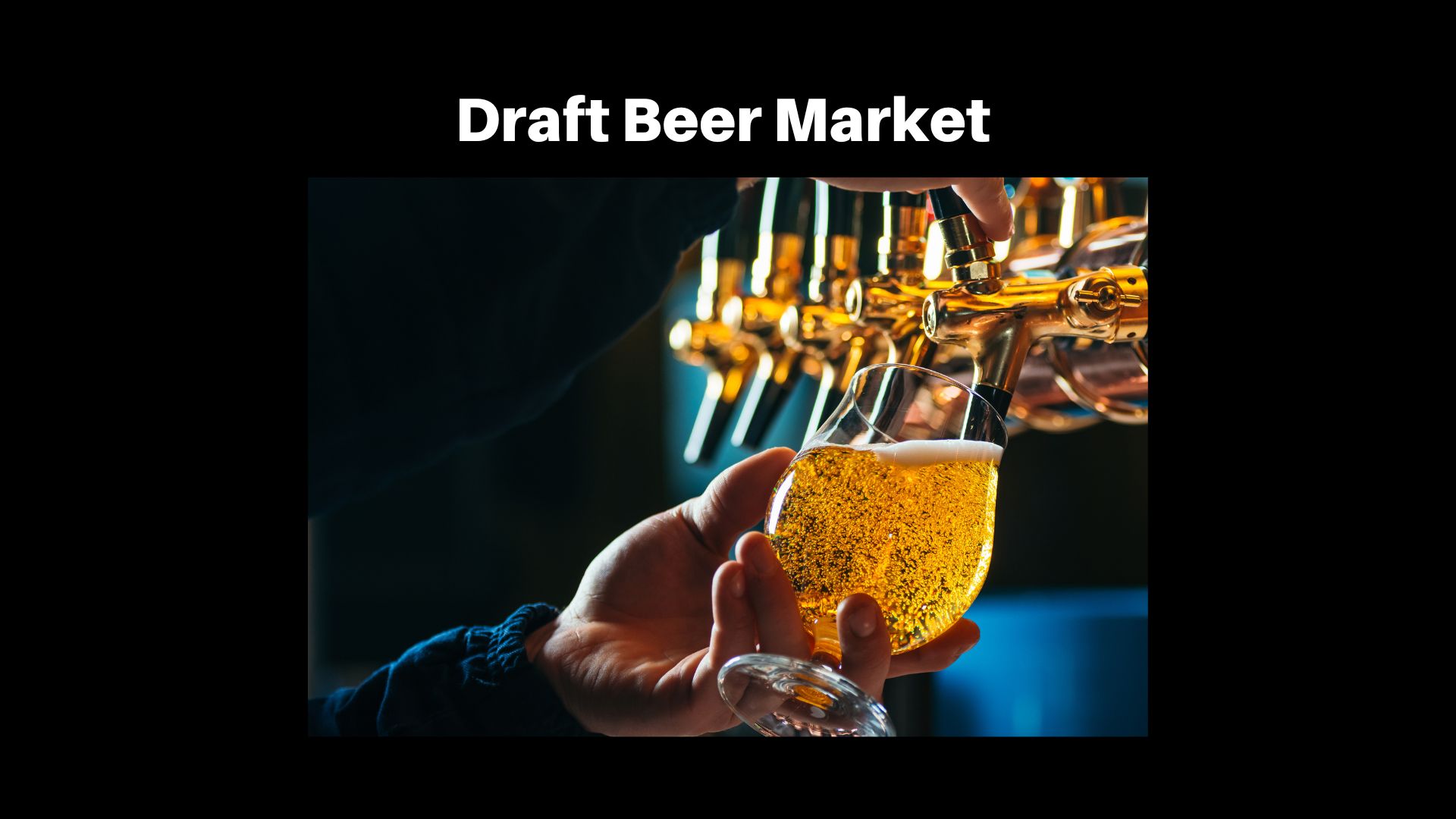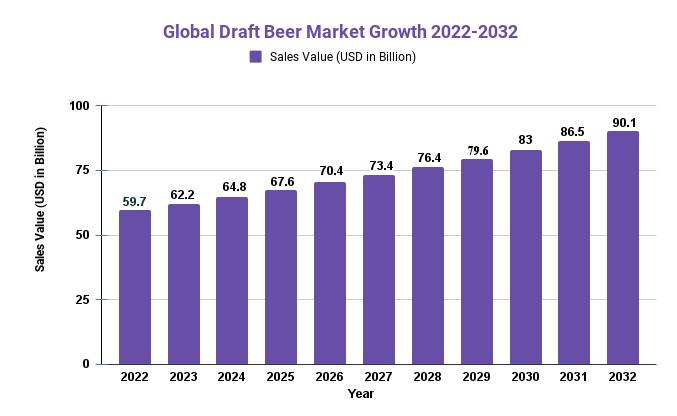Draft Beer Market is Estimated to Showcase Significant Growth of USD 90.1 Bn in 2032 With a CAGR 4.2%

Page Contents
Market Overview
Published Via 11Press: Global Draft Beer Market size is expected to reach USD 90.1 Bn by 2032, up from the forecasted value of USD 59.7 Bn in 2022 – growing at a compound annual growth rate (CAGR) of 4.2% from 2023-2032.
The growing demand for craft beer, rising disposable income levels, and shifting consumer preferences towards premium alcoholic beverages are some of the major factors fueling growth in the draft beer market.
North America currently leads the global draft beer market due to high consumption in countries like the United States and Canada. Europe follows, with countries like Germany, the United Kingdom, and Belgium playing a major role in driving growth within this sector. Asia Pacific is expected to experience the highest growth rate over the coming years due to an increasing number of microbreweries and shifting consumer preferences towards premium alcoholic beverages.
The major players in the global draft beer market include Anheuser-Busch InBev, Heineken N.V., Carlsberg A/S, Diageo plc, Molson Coors Brewing Company, and SABMiller plc. To expand their market share these companies are focusing on product innovation and expanding their distribution networks.
The COVID-19 pandemic had a significant effect on the draft beer market, as bar closures, restaurant closings, and pub closings resulted in decreased demand. However, easing restrictions and the reopening of these establishments are expected to help fuel growth within this sector over the coming years.

Drivers, trends, and challenges have an impact on market dynamics, which can impact businesses. Request for PDF sample report
Key Takeaways
- Global Draft Beer Market size is forecast to reach USD 90.1 Bn by 2032 from USD 59.7 Bn in 2022, growing at a compound annual growth rate (CAGR) of 4.2% between 2023 and 2032.
- The rising demand for craft beer, rising disposable income levels, and shifting consumer preferences towards premium alcoholic beverages are some of the major factors propelling growth in the draft beer market.
- North America dominates the global draft beer market, followed by Europe and Asia Pacific.
- Anheuser-Busch InBev, Heineken N.V., Carlsberg A/S, Diageo plc, Molson Coors Brewing Company, and SABMiller plc are some of the major players in this space.
Regional Snapshot
- North America is the leading market for draft beer, with major contributions from both the United States and Canada. Europe follows closely behind in second place with major contributions from Germany, the United Kingdom, and Belgium to this growth trajectory.
- The Asia Pacific region is expected to experience the highest growth rate due to an increasing number of microbreweries and shifting consumer preferences towards premium alcoholic beverages.
- Latin America, the Middle East, and Africa are expected to experience substantial growth over the coming years due to increasing demand for premium alcoholic beverages. Nonetheless, regulatory restrictions on the consumption of alcohol may limit this market's expansion in some countries.
Drivers
- Growing Demand for Craft Beer: As consumers seek out unique and flavorful beer options, craft beer has seen a dramatic spike in demand – often served on draft.
- Rise in Socializing At Bars And Pubs: With the growing trend towards more informal gatherings in bars and pubs, demand for draft beer has increased significantly – often considered fresher and of higher quality than bottled or canned options.
- Growing Popularity of Beer Tourism: As more and more people are visiting breweries and taprooms to sample local and regional beers, demand for draft beer continues to grow.
- Increased disposable incomes: The rise of middle classes in emerging economies, combined with rising disposable incomes, are fueling demand for premium beer – including draft beer.
Restraints
- COVID-19 Pandemic: The COVID-19 pandemic has had a profound effect on the draft beer market, with lockdowns and restrictions placed on social gatherings leading to decreased on-premise consumption.
- Government Regulations: Regulations regarding the sale and distribution of alcohol, as well as taxes on it, can affect demand for draft beer.
- Health Concerns: Growing awareness regarding the health risks associated with alcohol consumption could potentially limit demand for this beverage.
- Competition from other alcoholic and non-alcoholic beverages: Demand for draft beer may be affected by competition from other alcoholic and non-alcoholic drinks such as wine, spirits, and soft drinks.
Opportunities
- Innovation in flavors and brewing techniques: Breweries have the chance to innovate with flavors and brewing techniques as the craft beer market grows, offering them on draft for customers to sample. With such a demand for unique tastes in craft beer, breweries have an ideal platform to test out new methods of production and flavors.
- Online Sales and Home Delivery: The growing trend in online sales and home delivery of alcoholic beverages present breweries with an opportunity to expand their customer base and offer their draft beer products to a wider audience.
- Emerging Markets: As middle classes and disposable incomes in emerging markets such as Asia-Pacific and Latin America grow, breweries can take advantage of new opportunities to expand their business operations and reach new audiences.
- Sustainability: With the growing awareness of environmental concerns and sustainable practices, breweries now have an opportunity to incorporate sustainable methods into their production processes, such as using renewable energy or reducing waste.
Challenges
- Growing Competition: With the growing popularity of craft beer and an increase in breweries, breweries face an uphill battle to differentiate themselves and stand out in an increasingly crowded market.
- Supply chain Disruptions: The COVID-19 pandemic and other factors like climate change or natural disasters can disrupt the supply chain for raw materials, potentially impacting draft beer production.
- Regulations and taxes: Regulations related to the sale and distribution of alcohol, as well as taxes on it, can present a challenge for breweries to navigate and comply with.
- Health Concerns: With increased awareness of the potential hazards associated with alcohol consumption, breweries must work to promote responsible drinking practices and address any potential health concerns that arise.
Recent Developments
- The COVID-19 pandemic has forced many breweries and bars to turn to online sales and home delivery to stay afloat. This trend is likely to persist even as the crisis subsides, offering new opportunities for the draft beer market.
- Due to the growing demand for innovative and flavorful beers, many breweries are exploring new brewing techniques and ingredients, such as sour beers and fruit-infused ales.
- Sustainable brewing practices are becoming more and more essential in the industry, with many breweries investing in renewable energy sources, reducing waste generation, and using locally sourced ingredients.
Key Market Segments
Type
- Cask Draft Beer
- Keg Draft Beer
Application
- Corporate Hospitality
- Family Dinner
Key Market Players
- Beverage Air
- Beverage Factory
- Continental
- EdgeStar
- Everest
- Fagor
- Glastender
- Jarden
- KegWorks
- Micro Matic
- Omcan
- Perlick
- True Manufacturing
- Turbo AirFAQs
Report Scope
| Report Attribute | Details |
| The market size value in 2022 | USD 59.7 Bn |
| Revenue forecast by 2032 | USD 90.1 Bn |
| Growth Rate | CAGR Of 4.2% |
| Regions Covered | North America, Europe, Asia Pacific, Latin America, and Middle East & Africa, and Rest of the World |
| Historical Years | 2017-2022 |
| Base Year | 2022 |
| Estimated Year | 2023 |
| Short-Term Projection Year | 2028 |
| Long-Term Projected Year | 2032 |
Frequently Asked Questions
Q: Is draft beer more expensive than bottled or canned beer?
A: The price of draft beer can vary depending on factors such as the brewery, the type of beer, and the location. In general, draft beer may be slightly more expensive than a bottled or canned beer due
to factors such as the cost of kegs and tap systems.
Q: Is draft beer fresher than bottled or canned beer?
A: Draft beer is typically considered fresher than bottled or canned beer, as it is served directly from the keg and is not exposed to air or light, which can affect the flavor of the beer.
Q: Can I buy draft beer to take home?
A: In some locations, it is possible to purchase draft beer in growlers or crowlers (large containers filled with draft beer) to take home. However, regulations on the sale and distribution of alcohol vary by location and may restrict this practice.
Q: What is the difference between draft beer and keg beer?
A: Draft beer is a beer that is served from a tap, while keg beer refers to beer that is stored in a large container (called a keg) and can be served either on tap or from a can or bottle.
The team behind market.us, marketresearch.biz, market.biz and more. Our purpose is to keep our customers ahead of the game with regard to the markets. They may fluctuate up or down, but we will help you to stay ahead of the curve in these market fluctuations. Our consistent growth and ability to deliver in-depth analyses and market insight has engaged genuine market players. They have faith in us to offer the data and information they require to make balanced and decisive marketing decisions.



